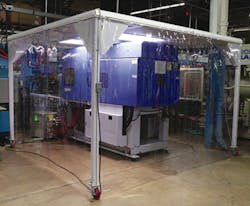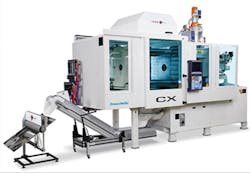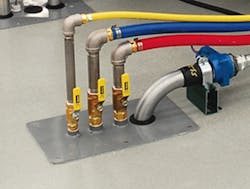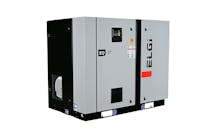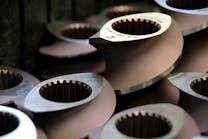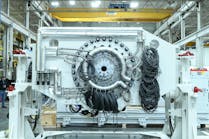Special Report: Many configurations possible when reducing contaminants
Clean rooms can vary greatly in size, specification and configuration — from a portable unit or small clean cell around a single piece of equipment to a large, fully equipped clean room to a clean room within a clean room within a clean room. While the form can vary, some functional aspects are essential. Configurations are continually evolving.
"Eliminating sub-micron airborne contamination is really a process of control," says Raul Reyes Jr., regional sales manager/customer service manager for MAC Automation Concepts Inc., Woodstock, Ill., which makes clean-room enclosures. "So, having a variety of controlled environment options enables molders to maximize efficiency of clean-room molding for a fraction of the cost of a clean-room facility."
Today, a number of configuration options are available. For example, in applications requiring increasingly stringent cleanliness, more automation is used, with robotics placed within the clean room or clean cell, says sales manager Jason Holbrook, of KraussMaffei Corp., Florence, Ky. Some customers even use a clean room within a clean room within a clean room. In such a system, the operator is in the main plant; an exterior clean room surrounds the clamp area of an injection molding machine; then, a clean cell is placed around the robot next to the clamp within the clean room where the parts are made. By doing this, Holbrook says, molders can isolate areas from particulates and limit contamination.
Another option, typically for a Class 10,000 clean room, is the placement of a "downdraft box" on the molding machine with a HEPA filter. "The filter blows the deionized air down through the clamp area, so that we have made a clean room of the equipment itself," Holbrook says.
MAKING OF A CLEAN ROOM
Whatever the exact size or shape clean rooms take, many of the structural features are the same.
For example, MAC offers:
• Hard panel walls. White textured, vinyl-covered blank panels of 0.5-inch gypsum, with all edges sealed. If required, custom sizes can be cut and edges resealed at MAC's factory.
• Clean-room curtains. Clear 40-mil curtains with two 12-inch overlap openings are standard, with other materials and entry options, including strip and sliding track, available.
• Beside-the-press clean rooms. The conveyor is fully enclosed within the positive-pressure HEPA enclosure. Parts drop onto it from the mold and are conveyed to a bag that is sealed and removed by an operator who reaches into the enclosure to do so.
MAC also offers antistatic material for sidewalls, air-conditioning and humidity control, built-in conveyors and worktables, automatic bag- or tote-fill systems, inspection tables, gowning room equipment, gowning rooms, ionizing equipment, carts, equipment for the areas that lead into and out of the clean room, safety equipment and accessories.
In all clean rooms, one key attribute is that the filtration units, lights, windows, etc., be completely sealed, with at least a small gap along the floor to allow particulates to exit when the "positive air flow" is on, says John Schanz, sales manager for Harvard Factory Automation (HFA), Harvard, Ill.
HFA builds its products to ensure continued compliance with requirements. Its portable enclosures have anodized aluminum and stainless-steel frames with clear PC walls. They feature antistatic vinyl curtains, heavy-duty casters for portability, HEPA filtration systems, fluorescent lighting, ABS ceiling and lower wall panels, openings for conveyor entrance/exit and operator-access doors. HFA also provides permanent enclosures.
Depending on the size of the clean room, robotics can be used both inside and out.
THE EVOLVING CLEAN ROOM
KraussMaffei has been working with clean-room applications for decades, but it's only been within the last 15 to 20 years manufacturers have combined operations within and outside clean rooms. Before that, equipment was simply taken out of the box and put into the clean room, Holbrook says. But eventually, with people tramping in and out, more particles could end up inside the clean room than outside. So processors began putting only the necessary machine parts in the clean room — such as the clamping unit. The injection unit and all auxiliary equipment and employees were stationed outside the room.
Some clean cells are, in fact, being shrunk so much, they can be picked up and moved, he says. What are the benefits to that? "When you shrink the volume of area you're trying to contain, the area you have to worry about becomes less and less and less, so the control becomes greater and greater and greater," Holbrook explains. This also enables tighter tolerances and makes way for more clean spaces in the plant because the cells take up less space.
"Square footage is a high commodity," Holbrook says. "And downsizing reduces cost, and you become more price competitive.
"Therein lies the innovation — that we continually target those three things: cleanliness, price reduction and square footage," he says.
STRIPPED-DOWN APPROACH
What goes on outside the clean room might be just as important as what's happening inside it.
Tim Noggle, senior VP of sales for auxiliary equipment maker Novatec Inc., Baltimore, says it's important to strip the clean room down to the barest essentials. His mantra is "Don't put it in the clean room." In particular, "don't put anything that has to be serviced in the clean room," he says. His aim is to avoid wasting the time it would take for workers to gown up to go into a clean room by keeping all but the most necessary equipment out. "The more you can keep equipment outside the room, the happier the customer is because they don't have to risk contamination by going in and out," he says.
As a manufacturer of conveying equipment, Novatec has found that processors who require a clean-room environment have the same approach — namely, they use the clean room to process material in the production machines — nothing else. "In that way, they almost never have a situation that they have to do maintenance in the clean room," Noggle says, adding, "Is that innovative or is that the smart thing to do? What we call it is listening to the customer. We meet their imperatives by not being intrusive."
This means that the way resin is brought into the clean room — and the way parts are removed — is just as critical as the equipment within the room.
There are different ways to configure the equipment and piping. For example, one Novatec customer took a centralized approach. All the equipment sits on one mezzanine in the plant, and the pipe and utilities run underground, then up through the floor of the clean room. Another Novatec customer places the equipment in a hallway outside the room and runs the lines overhead to the receiver in the clean room.
Comet Plastic Equipment LLC, Riviera Beach, Fla., doesn't manufacture its blending, drying, and conveying equipment specifically for clean rooms, but President Tom Rajkovich says it has customers who use some of its machines for their clean rooms. "The most important thing is that we don't put particulates in the room, so we put our dryers and our loading systems outside the clean room and plumb over to the room."
If a hopper loader is placed in the room, some dust will pass through the filter and, for most customers, that's not acceptable. So the hopper and other mixing and regrinding equipment are placed outside the molding area, allowing only dry material to be pulled into the clean room, and a central vacuum system is installed that passes out of the clean room.
KEEPING CONTAMINATION OUT
Reducing the clean room to its most essential functions is just one way to limit the amount of foot traffic in and out of it. Another approach is using machinery that requires little human interaction, by adopting automation or low-maintenance equipment. That's the approach that Conair Group, Cranberry Township., Pa., has pursued with a toolless material receiver. The receiver employs a wingnut to reduce movement in and out of the clean room. Minimizing movement reduces particulate generation. "That's important in the clean room because if you have people in the room, you have to go to the toolbox, then go back to the machine, then wrench on the part," says Matt Zelkovich, Conair's GM for medical. "People are the worst particulate generators in the clean room, so anywhere you can do toolless equipment, it's a benefit from a particulate movement perspective."
Ultimately, when designing and selecting equipment for the clean room, processors need to ask, "How easy is it to clean?" says Michael Werner, senior technical manager for Toshiba Machine Co. America, Elk Grove Village, Ill. Are there nooks and crannies for dust and dirt to collect? Even if they're not a safety factor, a machine's design features, such a T-slots, can raise red flags regarding cleanliness. For processors, other important considerations include available space, cost and customer requirements.
Lisa Jo Lupo, correspondent
llupo@plasticsmachinerymagazine.com
Contact:
Comet Plastic Equipment LLC,
800-328-5088, www.cometpe.com
Conair Group,
724-584-5500, www.conairgroup.com
Harvard Factory Automation,
815-943-1193, www.hfaconveyors.com
KraussMaffei Corp.,
859-283-0200, www.kraussmaffeigroup.us/en/
MAC Automation Concepts Inc.,
815-337-3000, www.macautomation.com
Novatec Inc.,
410-789-4811, www.novatec.com
Toshiba Machine Co. America,
847-709-7000, www.toshiba-machine.com

